8 - Mass Wasting, Weathering, and Soil
1/110
There's no tags or description
Looks like no tags are added yet.
Name | Mastery | Learn | Test | Matching | Spaced |
|---|
No study sessions yet.
111 Terms
External processes
Occur at or near Earth’s surface and are powered by energy from the Sun
Weathering, Mass wasting, Erosion
External processes
Weathering
the physical breakdown (disintegration) and chemical alteration (decomposition) of rocks at or near Earth’s surface
Mass wasting
the transfer of rock and soil downslope under the influence of gravity
Erosion
the physical removal of material by mobile agents such as water, wind, or ice
Mechanical weathering
the process that breaks material into smaller and smaller pieces, each retaining the characteristics of the original material
Frost wedging
continuous freezing and thawing weakens the rocks and making them into smaller pieces
Frost heave
expansion of moist soils during freezing due to growth of ice lenses
Salt crystal growth
expansive force that can split rocks due to growth of salt crystals
Sheeting
the process of unloading and exfoliation
Unloading
a process where great reduction in pressure is experienced by a rock when the overlying rock is eroded away
Exfoliation dome
created from continued weathering that causes the slabs lto separate and spall off
Sheeting
Caused by the expansion of crystalline rock as erosion removes the overlying material
Intense heat from brush or forest fire
it can cause flakes of rock to spall from boulders or bedrock. As the rock surface becomes overheated, a thin layer expands and shatters
Root wedging, Burrow, Human actions
Biological activity
Chemical weathering
involves the processes that break down rock components and internal structures of minerals.
Water
the most important agent of chemical weathering
Acid (carbonic acid)
readily decomposed many rocks and produce certain products that are water soluble
Feldspar will breakdown into residual clay minerals, and quartz will survive the chemical weathering
What will happen to the weathering of granite
Aluminum, silicates, and oxygen, together with water will produce residual clay minerals
What will happen to the weathering of silicate minerals
Spheroidal weathering
Form of chemical weathering that affects jointed bedrock and results in the formation of concentric or spherical layers of highly decayed rock within weathered bedrock
Rock characteristics
The most important factor that influences the type and rate of rock weathering, it encompasses all of the chemical traits of rocks, including mineral composition and solubility
Temperature and moisture
crucial to the rate of rock weathering. Also exert a strong influence on rates of chemical weathering and on the kind and amount of vegetation present
Differential weathering
Masses of rock do not weather uniformly
Soil
A combination of mineral and organic matter, water, and air - that portion of the regolith that supports the growth of plants
Regolith
Covers the Earth’s land surface and the layer of rock and mineral fragments produced by weathering
Humus
The organic component of soil, formed by the decomposition of leaves and other plant material by soil microorganisms
Residual soil
The term for soil when their parent material is bedrock
Transported soil
Soil developed on unconsolidated sediment
Time
an important component of every geological process, and soil formation is no exception
Climate
the most influential control of soil formation. They also influence the rate and depth of weathering
Parent material, Time, Climate, Plants and animals, Topography
Controls of soil formation
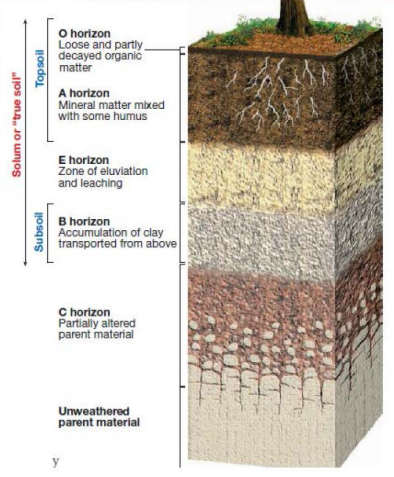
Horizons
vertical differences which usually become more pronounced as time passes, divide the soil into zones or layers
O horizon
Consists largely of organic material
A horizon
a largely mineral matter, yet biological activity is high and humus is generally present at up to 30% in some instances
A and O horizon
They compose the topsoil
E horizion
light-colored layer that contains little organic material. Zone of eluviation and leaching
Eluviation
The washing out of the fine soil components as water percolates downward
Leaching
Depletion of soluble materials from the upper soil
B horizon
also known as the subsoil, accumulation of clay transported from above. Zone of accumulation
Hardpan
An impermeable layer formed in extreme cases from accumulation of clay
O, A, E, and B horizioons
The true soil or solum
Solum
it is where the soil-forming processes are active and that living roots and other plant and animal life are largely confined
C horizon
a layer characterized by partially altered parent material
Mature
A well-developed soil profile with relatively stable environmental conditions over an extended time span
Immaturew
Soil that lack horizons altogether and also characteristic of steep slopes where erosion continually strips away the soil, preventing full development
Alfisol
Moderately weathered soil the form under boreal forests or broadleaf deciduous forests, rich in iron and aluminum. Fertile productive soil because they are neither too wet nor too dry
Andisol
Young soils from volcanic ash and cinders deposited by recent volcanic activity
Aridosol
Soils that develop in dry places, may have an accumulation of calcium carbonate, gypsum, or salt in subsoil with law organic content
Entisol
Young soils having limited development and exhibiting properties of the parent material
Gelisol
Young soils with little profile development that occur in regions with permafrost. Low temp and frozen conditions for much of the year slow soil-forming conditions
Histosol
Organic soils with little or no climatic implications. Can be found in any climate where bog soil can form. Has peat
Inceptisol
Weakly developed young soils in which the beginning of profile development is evident. In the beginning. Most common in humid climates
Mollisol
Dark, soft soils that have developed under grass vegetation generally found in prairie areas. Humus-rich surface horizon that is rich in Ca and Mg. Excellent soil fertility
Oxisol
Soils that occur on old land surfaces unless parent materials were strongly weathered before they were deposited. Found in tropics and subtropics. Rich in iron and aluminum oxides and heavily leached, poor for agriculture
Spodosol
Soils found only in humid regions on sandy material. Has light-colored horizon of leached material
Ultisol
Soils that represent the products of long periods of weathering, restricted to humid climates
Vertisol
Soils containing large amounts of clay, which shrink upon drying and swell with the addition of water. Found in subhumid to arid climates
Andisol, Histosol, Vertisol
3 orders with unique parent materials
Aridisol, Gelisol, Oxisol
3 orders with unique environments
Entisol, Inceptisol, Ultisol
3 orders by age of development
Alfisol, Mollisol, Spodosol
3 orders by unique vegetative influence
Rills
Tiny channels formed during soil erosion
Gullies
Deeper cuts in the soil as rills are enlarged
Bauxite
A principal ore of aluminum and forms as a result of weathering processes under tropical conditions
Landslide
Mass wasting in layman
Landslide
A catastrophic event that endangers human’s life
Mass wasting
The downslope movement of rocks, regolith, and soil under the direct influence of gravity
Processes the shape of the surface of the Earth
Step that follows weathering
Roles of Mass wasting
Water or moisture content
Angle of repose
Vegetation
Seismicity
Controls and triggers of mass wasting
Water saturation
Reduces friction and soil cohesion, weakening the soil
Oversteepened slopes
A factor where changing the slope to accommodate a new house or road can lead to instability and a destructive mass wasting event
Angle of repose
The steepest angle at which a material remain stable
25-40 degrees
Angles of repose
Removal of Vegetation
Plants protect against erosion and contribute to the stability of slopes, they bind soil and regolith together
Seismicity
An earthquake and its aftershocks can dislodge enormous volumes of rock and unconsolidated material.
Liquefaction
Intense ground shaking during earthquakes can cause water saturated surface materials to lose their strength and behave as fluid-like masses that flow
Disrupted slides and falls
Coherent slides
Lateral spreads and flows
3 main categories of earthquake induced landslides
Past landslides and their distribution
Bedrock
Slopes steepness or inclination
Hydrologic factor
Human-initiated effects
Geology
Topography
Proximity to drainage
Lithology
Proximity to faults
Geomorphologic/terrain units
factors inherent to soil conditions for EIL
Debris/mud/earth, and rock
types of material
Fall, Slide, and Flow
Type of motion
Fall
Movement involves the freefall of detached individual pieces of any size.
Slide
distinct zone of weakness separating the slide material from the more stable underlying material
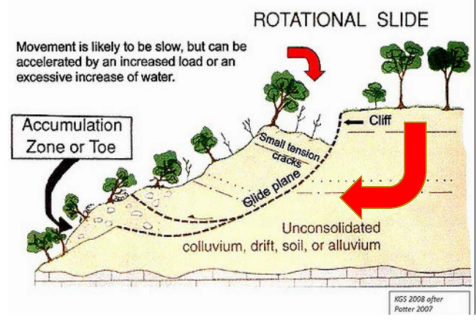
Rotational slide
concave-upward curve that resembles the shape of a spoon
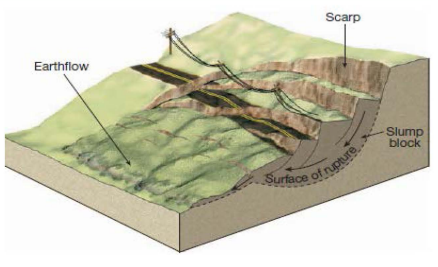
Slumping
refers to the downward sliding of a mass of rock or unconsolidated material moving as a unit along a curved surface
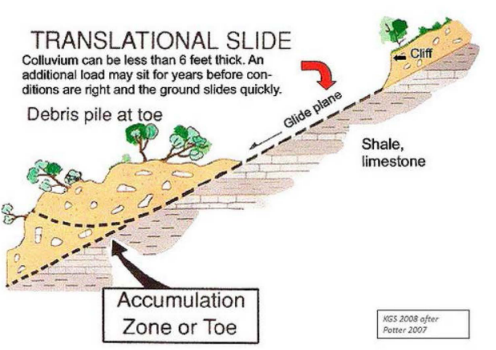
Translational slide
mass of material moves along a relatively flat surface such as fault, joint, or bedding plane
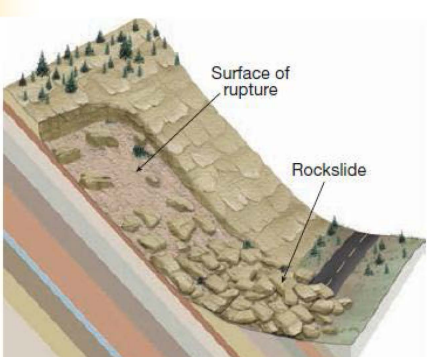
Rock slide
fast downslope sliding of a block of rock
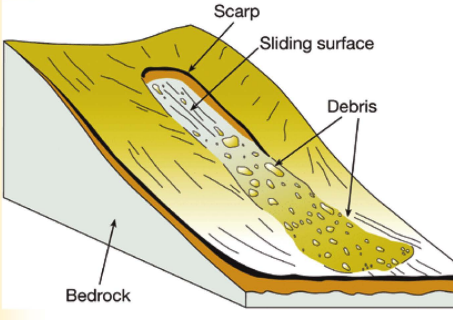
Debris slide
Fast downslope sliding of largely unconsolidated material
Flow
occurs when material moves downslope as a viscous saturated with water and typically moves as earth or tongue-like
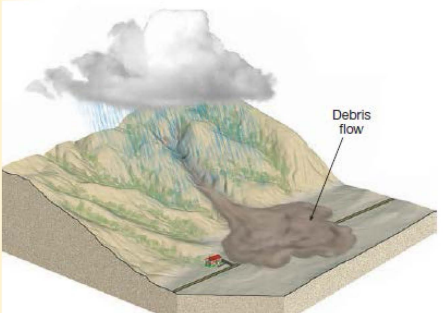
Debris flow
a moving tongue-like of well-mixed mud, soil, rock, and water
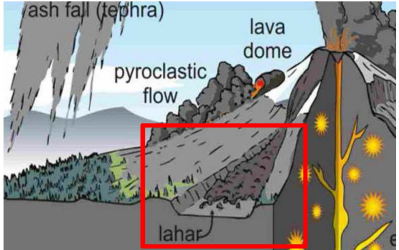
Lahar
debris flow composed of volcanic materials on the flanks of volcanoes
Mud flow
Flow that consists primarily of fine-grained material
Earthflow
most often form on hillsides in humid areas during times of heavy precipitation or snowmelt. Move at slower rate than debris flow
Rockfall
landslide composed of rock materials and in rapid movement and fall motion
debris slide
composed of debris and slide motion with moderate mass movement
Creep and Solifluction
slow mass movement
Creep
gradual downhill movement of soil and regolith
The alternate expansion and contraction of surface material caused by freezing and thawing or wetting and drying
Factor that contributes to creeping
Solifluction
a type of mass wasting that is common wherever water can not escape from the saturated surface layer by infiltrating to deeper levels
Permafrost
permanently frozen ground that occurs in association with Earth’s harsh tundra and ice-cap climates